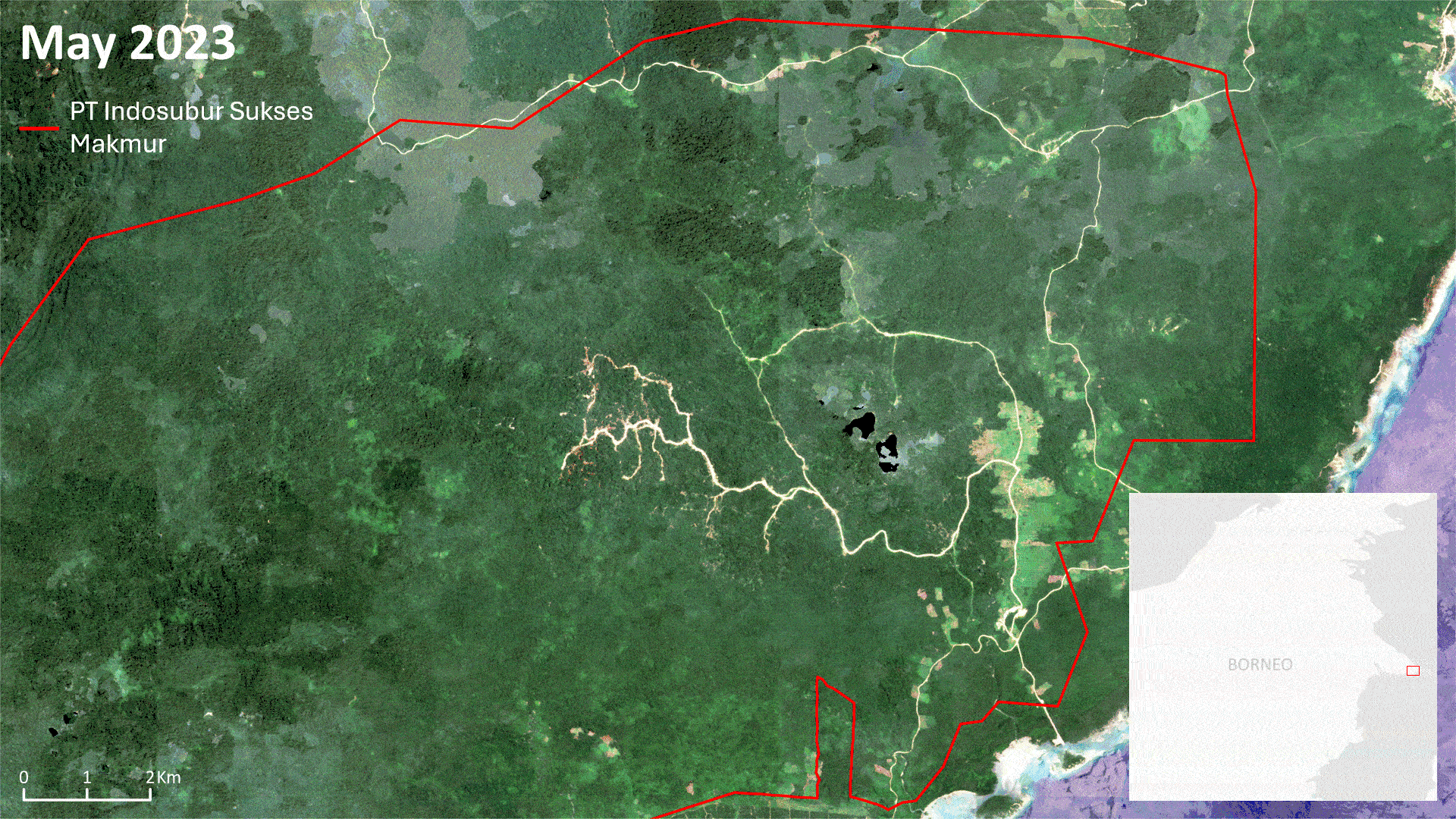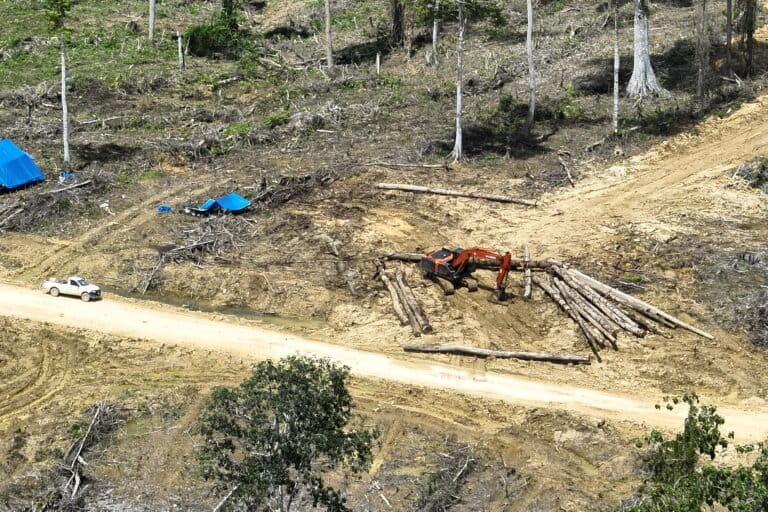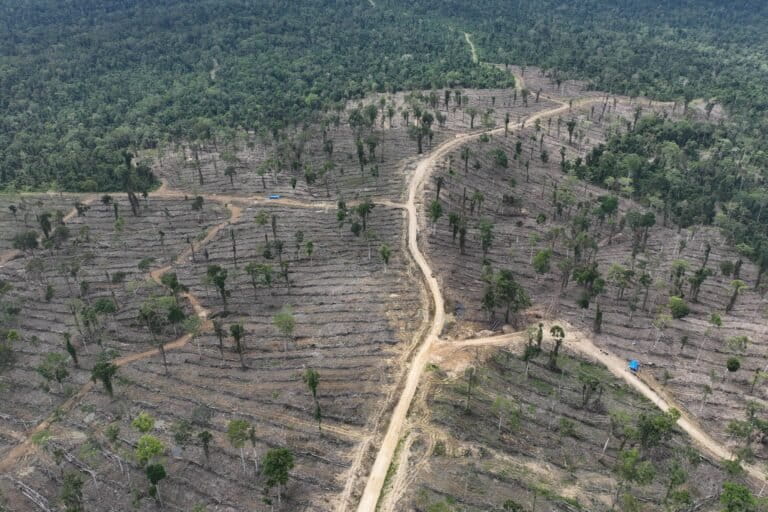- Investigations by the NGOs Earthsight, Auriga Nusantara and Mighty Earth have found that plywood from forests cleared in Indonesian Borneo — including critical orangutan habitat — is ending up in U.S. RVs made by brands like Jayco, Winnebago and Forest River.
- Logs from a concession held by PT Indosubur Sukses Makmur were traced to plywood giant KLAM, then exported via U.S. intermediaries (MJB Wood, Tumac Lumber and Patrick Industries) into RV manufacturing supply chains.
- Indonesia allows legal clearing of natural forests, while the U.S. bans only illegal logging under the Lacey Act — creating a loophole that lets deforestation-linked wood enter supply chains unchecked.
- FSC-certified sustainable alternatives exist and would add as little as $20 to an RV’s price, but RV makers prioritize low costs, critics say; experts call for stronger Indonesian protections and U.S. deforestation-free import laws.
JAKARTA — Global calls are mounting for RV companies in the U.S. to change their policies following new revelations that some of America’s best-selling RVs are built with plywood from the destruction of orangutan habitat in Indonesian Borneo.
While companies like Winnebago say they’re now “working quickly to better understand the concerns raised,” environmentalists warn that corporate and regulatory inaction continues to drive the loss of Indonesia’s rainforests.
Two reports — by U.K.-based NGO Earthsight and Indonesian environmental group Auriga Nusantara as well as U.S.-based campaign group Mighty Earth — trace how tropical timber from rainforest clearance in Indonesia enters the supply chains of leading U.S. RV makers, including Jayco, Winnebago and Forest River.
The findings highlight governance gaps in Indonesia, where forest clearing for industrial concessions remains legal, and regulatory weaknesses in the U.S., whose laws prohibit illegal logging but not legal deforestation.
Since the investigations were published, Mighty Earth has published a petition to urge RV companies to change their timber sourcing policies to exclude any wood from deforestation.
The online petition seeks 1,500 signatures and so far has garnered more than 1,000.
“Before it’s too late, it’s time to protect our rainforests, uphold the rights of Indigenous communities, and save the incredible animals that live there,” the petition says. “Tell RV CEOs: We demand that you only use deforestation-free and Forest Stewardship Council-certified wood in your supply chains and RV manufacture.”

Forest clearance on the ground
The trail begins in East Kalimantan province, eastern Borneo, where Auriga and Earthsight visited an industrial timber concession operated by PT Indosubur Sukses Makmur (ISM).
Satellite analysis shows the company has been clearing natural forest since at least 2021, destroying 1,200 hectares (about 3,000 acres) to date, including 138 hectares (340 acres) in 2025 alone. That’s the equivalent of three American football fields of rainforest each day.

These forests are home to critically endangered orangutans (Pongo pygmaeus) and endangered proboscis monkeys (Nasalis larvatus). ISM’s 28,000-hectare (69,200-acre) concession overlaps with orangutan habitat in the Sangkulirang-Mangkalihat karst, a prehistoric landscape being considered for recognition as a UNESCO World Heritage Site. Officials estimate only 310 orangutans remain there.
“Their survival is gravely threatened by this deforestation,” said Hilman Afif, a campaigner at Auriga.

The karst system is also vital for groundwater absorption and conservation.
“This shows that PT ISM’s presence in this landscape accelerates the ecological crisis by threatening biodiversity and undermining vital environmental functions for both humans and wildlife,” Hilman said.
Local Indigenous communities say the clearance has disrupted their livelihoods and that there’s been minimal communication and compensation from ISM.

From Borneo to America’s highways
Where does the felled timber go?
Auriga and Earthsight traced ISM’s logs to Indonesian plywood giant PT Kayu Lapis Asli Murni (KLAM). In 2024, ISM supplied 17,853 cubic meters (630,473 cubic feet) of natural forest timber to KLAM — 87% of the mill’s total roundwood intake that year. The bulk of it was meranti, or lauan, a lightweight, flexible and moisture-resistant tropical hardwood ideal for bending into RV sidewalls.
KLAM exported much of this plywood to the U.S. Half of its 2024 shipments went to two U.S. intermediaries: MJB Wood and Tumac Lumber. As recently as April 2025, seven containers of KLAM plywood arrived in the U.S. port of Baltimore, destined for MJB Wood.
MJB Wood also reportedly sourced lauan from two other Indonesian suppliers tied to deforestation, according to Earthsight.
From there, the supply chain splinters.
First, MJB Wood directly supplies Jayco, the best-selling RV brand owned by Thor Industries, the world’s largest RV maker.
Second, both MJB Wood and Tumac Lumber supply Patrick Industries, an RV parts manufacturer whose customers include three of the largest RV manufacturers in the U.S.: Thor, Forest River and Winnebago.

Earthsight notes it’s impossible to say with certainty whether a particular RV contains deforestation-linked plywood. But given the quantities involved, it is “almost certain” that U.S.-bound plywood from KLAM and other Indonesian mills includes wood from deforestation in Borneo.
A parallel investigation by U.S. campaign group Mighty Earth found similar patterns in western Borneo. Timber felled in West Kalimantan province by PT Mayawana Persada, one of Indonesia’s most notorious industrial deforesters, was processed by PT Asia Forestama Raya (AFR) on the neighboring island of Sumatra, before being exported to California-based Transindo USA. Transindo confirmed AFR is one of its suppliers, but declined to comment on Mayawana. The plywood was sold on to Patrick Industries.
“The use of meranti plywood is the RV industry’s dirty secret,” said Amanda Hurowitz, forest commodities lead at Mighty Earth.
A spokesperson for Winnebago Industries said the company “cares deeply about our planet” and that its teams are “working quickly to better understand the concerns raised in the report and take any appropriate actions.”
The company didn’t respond directly to questions about whether its RVs currently use plywood linked to deforestation in Indonesia.
Thor, Forest River and Mayawana Persada didn’t respond to Mongabay’s requests for comment. Thor told The New York Times that its suppliers are forbidden by U.S. law to buy illegal timber, and that it wasn’t aware of any deforested wood in its supply chain.

A consumer paradox
The revelations land awkwardly for an industry built on Americans’ love of the outdoors. RV ownership has soared in recent years, with more than 8 million U.S. households now owning one.
The number one reason Americans give when they buy RV is their love of nature and the great outdoors, the RV Industry Association notes.
For Anna Montgomery, a resident of Charleston, South Carolina, a $77,000 Winnebago Minnie Winnie seemed like the perfect way to spend time with her family in nature. She admired its wood finish. But she never imagined her RV might be tied to rainforest destruction.
“It wasn’t anything that I had thought about,” Montgomery said as quoted by The New York Times. “Here I am thinking, I got a good RV but what is the reality of it?”
Industry insiders say U.S. RV makers have relied on lauan plywood since the 1970s because it’s strong, light and cheap. Without it, manufacturers would have to use heavier alternatives that reduce fuel efficiency and compromise safety.
Today, RV makers are the biggest U.S. users of tropical plywood, overtaking construction. In 2024, U.S. imports of lauan plywood jumped 88%, most of it from Indonesia.
That same year, the U.S. overtook Japan as Indonesia’s second-largest plywood export market (after China).
Earthsight and Auriga estimate around 500 meranti trees are felled in Indonesia each year to supply the U.S. RV industry.
“Unwitting, nature-loving [RV] owners in the U.S. would be horrified to learn that the wood in their vehicles can be traced to deforestation threatening the lives of people and critically endangered Bornean orangutans in Indonesia’s rainforests,” Hurowitz said.

Cheap fixes, ignored
Sustainable alternatives exist.
Auriga notes that roughly 30% of meranti logs used in Indonesian mills already come from forests certified by the Forest Stewardship Council (FSC), the world’s leading ethical wood certifier.
Yet none of the lauan plywood traced to U.S. RVs was FSC-certified, Hilman of Auriga said. KLAM bought no certified logs in 2024.
That absence is especially striking because the cost of going sustainable is negligible. If RV makers demanded FSC-certified lauan, the average cost of a vehicle would rise by at most $20 — or 0.06%. “With a travel trailer selling for $33,000, that’s negligible,” Hilman said. “They could even absorb the cost entirely.”
At the height of the RV boom in 2022, Thor posted $2.2 billion in profits. Yet, according to one plywood industry insider quoted by Earthsight, “The RV companies never ask about sustainability. All they care about is price.”

Legal loopholes and weakened safeguards
The investigations highlight systemic failures in both Indonesia and the U.S.
In Indonesia, industrial forest concessions like ISM’s are allowed to clear natural forest legally. “The root of the problem lies in the Ministry of Forestry: Why are they granting [logging] permits in natural forests?” asked Auriga director Timer Manurung.
He said companies are effectively pressured to clear all the trees in their concessions, or risk having their annual work plans rejected. “I’ve met businesspeople with good management practices and good intentions, but they despair at the government,” Timer said.
Indonesia’s timber legality system, known as SVLK, was once praised internationally. In 2021 it was expanded to cover sustainability as well as legality. But new guidelines introduced in 2022 weakened its standards, critics say.
Requirements for biodiversity protection, conservation set-asides, and reduced-impact logging were either scrapped or absorbed into narrower legality definitions.
“This is a pity, because SVLK has been running for 15 years, and the standard should have been raised — but instead environmental protection has become more relaxed,” said Mardi Minangsari, a forestry expert from Indonesian environmental NGO Kaoem Telapak.
Access to information, one of the SVLK system’s key selling points, has also been curtailed.
“Last year, much public information was reclassified as ‘restricted.’ Now there is almost nothing we can access,” Mardi said. “How can [the government] talk about strengthening governance while restricting transparency?”
In the U.S., the Lacey Act bans imports of illegally harvested wood — but not timber from legal deforestation, like ISM’s. Nor does it require importers to trace wood beyond species and country of harvest.
“If deforestation wood is not illegal here, then it cannot be covered by the Lacey Act because no law is being broken,” Mardi said. “The U.S. will say: ‘Is it illegal in Indonesia to cut natural forests? If not, who are we to forbid it?’”
In Europe, by contrast, the upcoming EU Deforestation Regulation (EUDR) requires proof that timber is both legal and deforestation-free, including geolocation data.
“So the U.S. is very weak,” said timber supply chain expert Diah Suradiredja. “Under the Lacey Act, the U.S. cannot blame the RV industry because the problem is at the country level.”

What must change
Experts say reforms are needed on both sides of the Pacific.
In Indonesia, Hilman urged full legal protection for all natural forests and a strengthened SVLK system. Timer said Indonesia’s forestry road map must incentivize companies that practice selective logging rather than blanket clearing.
In the U.S., Hilman called for laws akin to the EUDR. At a minimum, enforcement of the Lacey Act should include traceability to ensure imports are deforestation-free.
But without the political momentum necessary to push these measures, the onus falls on RV manufacturers.
“America’s RV giants need to get out of the 1980s and implement the kinds of minimum sustainability standards other U.S. corporates have had in place for decades,” said Sam Lawson, Earthsight’s director.
Hurowitz of Mighty Earth said RV manufactures in the U.S. should adopt similar policies like American home improvement giant Home Depot, which adopted a new policy in 2024 that requires independent third-party sustainability certification, like the FSC, for all wood used in its products which was harvested in Borneo or Sumatra, the Indonesian islands where meranti/lauan grows.
“It doesn’t have to be this way — the RV industry in Indiana and beyond can stop using timber tied to deforestation and adopt responsible sourcing policies,” Hurowitz said. “We’re urging the big RV manufacturers to follow the lead of major American retailers such as Lowe’s and Home Depot who buy only sustainable timber.”
Failure to do so means Indonesia will continue to lose its rainforests, a critical ecosystem for climate change as it stores immense amounts of carbon and releases them when cleared, Timer warned.
For U.S. consumers buying RVs to escape into nature, the hidden cost may be the destruction of the very rainforests that sustain the planet.
“Indonesia has already lost 23 million hectares [57 million acres], or 20%, of its rainforests since 1990, at an immense cost to our climate, ecosystems and Indigenous peoples,” Timer said. “The destruction has to stop. Companies in the United States and worldwide must clean up their supply chains by excluding timber from deforestation, including from Indonesia.”
Banner image: A Bornean Orangutan in Central Kalimantan province, Indonesia. Image by Rhett A. Butler/Mongabay.
FEEDBACK: Use this form to send a message to the author of this post. If you want to post a public comment, you can do that at the bottom of the page.
